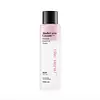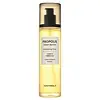What's inside
What's inside
 Key Ingredients
Key Ingredients

 Benefits
Benefits

 Concerns
Concerns

No concerns
 Ingredients Side-by-side
Ingredients Side-by-side

Water
Skin ConditioningCetyl Ethylhexanoate
EmollientPropanediol
SolventHydrogenated Polyisobutene
EmollientHydrogenated Poly(C6-14 Olefin)
EmollientAlcohol
AntimicrobialPanthenol
Skin ConditioningGlycerin
HumectantDipropylene Glycol
Humectant1,2-Hexanediol
Skin ConditioningCentella Asiatica Extract
CleansingMilk Protein Extract
Prunus Armeniaca Fruit Extract
Skin ConditioningCinnamomum Cassia Bark Extract
MaskingSolanum Melongena Fruit Extract
Skin ConditioningHydrogenated Lecithin
EmulsifyingPhytosteryl/Octyldodecyl Lauroyl Glutamate
Skin ConditioningAvena Sativa Meal Extract
SoothingBeta-Glucan
Skin ConditioningZingiber Officinale Root Extract
MaskingCentella Asiatica Leaf Extract
Skin ConditioningCeramide NP
Skin ConditioningSodium Hyaluronate
HumectantMadecassoside
AntioxidantEclipta Prostrata Extract
Skin ConditioningMelia Azadirachta Leaf Extract
Skin ConditioningButylene Glycol
HumectantMoringa Oleifera Seed Oil
EmollientDipotassium Glycyrrhizate
HumectantCaprylic/Capric Triglyceride
MaskingHydroxyacetophenone
AntioxidantPEG-40 Hydrogenated Castor Oil
EmulsifyingPolysorbate 20
EmulsifyingCaprylyl Glycol
EmollientEthylhexylglycerin
Skin ConditioningDisodium EDTA
Parfum
MaskingAlpha-Isomethyl Ionone
PerfumingLimonene
PerfumingHydroxycitronellal
PerfumingLinalool
PerfumingWater, Cetyl Ethylhexanoate, Propanediol, Hydrogenated Polyisobutene, Hydrogenated Poly(C6-14 Olefin), Alcohol, Panthenol, Glycerin, Dipropylene Glycol, 1,2-Hexanediol, Centella Asiatica Extract, Milk Protein Extract, Prunus Armeniaca Fruit Extract, Cinnamomum Cassia Bark Extract, Solanum Melongena Fruit Extract, Hydrogenated Lecithin, Phytosteryl/Octyldodecyl Lauroyl Glutamate, Avena Sativa Meal Extract, Beta-Glucan, Zingiber Officinale Root Extract, Centella Asiatica Leaf Extract, Ceramide NP, Sodium Hyaluronate, Madecassoside, Eclipta Prostrata Extract, Melia Azadirachta Leaf Extract, Butylene Glycol, Moringa Oleifera Seed Oil, Dipotassium Glycyrrhizate, Caprylic/Capric Triglyceride, Hydroxyacetophenone, PEG-40 Hydrogenated Castor Oil, Polysorbate 20, Caprylyl Glycol, Ethylhexylglycerin, Disodium EDTA, Parfum, Alpha-Isomethyl Ionone, Limonene, Hydroxycitronellal, Linalool
Propolis Extract 83%
Skin ConditioningGlycerin
Humectant1,2-Hexanediol
Skin ConditioningPropanediol
SolventNiacinamide
SmoothingDipropylene Glycol
HumectantCentella Asiatica Extract
CleansingPortulaca Oleracea Extract
Skin ConditioningPhellinus Linteus Extract
Skin ConditioningArctium Lappa Root Extract
Skin ConditioningScrophularia Buergeriana Extract
Skin ConditioningHoney Extract
HumectantSaccharomyces Ferment Filtrate
HumectantHedera Helix Leaf/Stem Extract
AntimicrobialVanilla Planifolia Fruit Extract
Skin ConditioningOcimum Sanctum Leaf Extract
Skin ConditioningCucumis Melo Fruit Extract
Skin ConditioningCamellia Sinensis Leaf Extract
AntimicrobialCorallina Officinalis Extract
Skin ConditioningLactobacillus Ferment Lysate
Skin ConditioningVitex Agnus-Castus Extract
AstringentChamomilla Recutita Flower Extract
MaskingAdenosine
Skin ConditioningMelia Azadirachta Leaf Extract
Skin ConditioningMelia Azadirachta Flower Extract
Skin ConditioningPyrus Communis Fruit Extract
Skin ConditioningPanthenol
Skin ConditioningCurcuma Longa Root Extract
Masking3-O-Ethyl Ascorbic Acid
Skin ConditioningRosa Damascena Flower Water
MaskingPrunus Persica Fruit Extract
AbrasiveSodium Hyaluronate
HumectantCetyl Ethylhexanoate
EmollientJasminum Officinale Flower Water
MaskingDextrin
AbsorbentTheobroma Cacao Extract
Skin ConditioningCaprylic/Capric Triglyceride
MaskingWater
Skin ConditioningVinyldimethicone
Polyglyceryl-4 Caprate
EmulsifyingPolyglyceryl-4 Oleate
EmulsifyingHydrogenated Lecithin
EmulsifyingXanthan Gum
EmulsifyingPhytosteryl/Octyldodecyl Lauroyl Glutamate
Skin ConditioningCeramide NP
Skin ConditioningBeta-Glucan
Skin ConditioningPropolis Extract 83%, Glycerin, 1,2-Hexanediol, Propanediol, Niacinamide, Dipropylene Glycol, Centella Asiatica Extract, Portulaca Oleracea Extract, Phellinus Linteus Extract, Arctium Lappa Root Extract, Scrophularia Buergeriana Extract, Honey Extract, Saccharomyces Ferment Filtrate, Hedera Helix Leaf/Stem Extract, Vanilla Planifolia Fruit Extract, Ocimum Sanctum Leaf Extract, Cucumis Melo Fruit Extract, Camellia Sinensis Leaf Extract, Corallina Officinalis Extract, Lactobacillus Ferment Lysate, Vitex Agnus-Castus Extract, Chamomilla Recutita Flower Extract, Adenosine, Melia Azadirachta Leaf Extract, Melia Azadirachta Flower Extract, Pyrus Communis Fruit Extract, Panthenol, Curcuma Longa Root Extract, 3-O-Ethyl Ascorbic Acid, Rosa Damascena Flower Water, Prunus Persica Fruit Extract, Sodium Hyaluronate, Cetyl Ethylhexanoate, Jasminum Officinale Flower Water, Dextrin, Theobroma Cacao Extract, Caprylic/Capric Triglyceride, Water, Vinyldimethicone, Polyglyceryl-4 Caprate, Polyglyceryl-4 Oleate, Hydrogenated Lecithin, Xanthan Gum, Phytosteryl/Octyldodecyl Lauroyl Glutamate, Ceramide NP, Beta-Glucan
 Reviews
Reviews

Ingredients Explained
These ingredients are found in both products.
Ingredients higher up in an ingredient list are typically present in a larger amount.
1,2-Hexanediol is a synthetic liquid and another multi-functional powerhouse.
It is a:
- Humectant, drawing moisture into the skin
- Emollient, helping to soften skin
- Solvent, dispersing and stabilizing formulas
- Preservative booster, enhancing the antimicrobial activity of other preservatives
Beta-Glucan is a polysaccharide. It can be derived from the cell walls of seaweed, oats, yeast, and fungi. It hydrates the skin and helps boost your skin's natural barrier.
As an antioxidant, beta-glucan helps fight free-radicals. Free-radicals are molecules that may damage your skin cells, such as pollution.
Studies show this ingredient may be an effective wrinkle reducer as it can deeply penetrate into skin. It has also been show to help with wound healing.
Learn more about Beta-GlucanThis ingredient is an emollient, solvent, and texture enhancer. It is considered a skin-softener by helping the skin prevent moisture loss.
It helps thicken a product's formula and makes it easier to spread by dissolving clumping compounds.
Caprylic Triglyceride is made by combining glycerin with coconut oil, forming a clear liquid.
While there is an assumption Caprylic Triglyceride can clog pores due to it being derived from coconut oil, there is no research supporting this.
Learn more about Caprylic/Capric TriglycerideCentella Asiatica Extract (Centella) is derived from an herb native to Southeast Asia. It is famous for its anti-inflammatory and soothing properties.
Centella is rich in antioxidants and amino acids, such as Madecassic Acid and Asiaticoside.
Studies show the compounds in centella help with:
The combination of all these properties makes centella effective at soothing, hydrating, and protecting the skin.
Other great components of centella include Vitamin A, vitamin C, several B vitamins, and Asiatic Acid.
Fun fact: Centella has been used as a medicine and in food for many centuries. As a medicine, it is used to treat burns, scratches, and wounds.
Learn more about Centella Asiatica ExtractCeramide NP is a type of ceramide and formally known as ceramide 3.
Ceramides are intercellular lipids naturally found in our skin that bonds dead skin cells together to create a barrier. They are known for their ability to hold water and thus are a great ingredient for dry skin.
Ceramides are an important building block for our skin barrier. A stronger barrier helps the skin look more firm and hydrated. By bolstering the skin ceramides act as a barrier against irritating ingredients. This can help with inflammation as well.
If you would like to eat ceramides, sweet potatoes contain a small amount.
Read more about other common types of ceramides here:
Ceramide AP
Ceramide EOP
Cetyl Ethylhexanoate is an emollient ester. It comes from cetearyl alcohol and 2-ethylhexanoic acid.
Cetyl Ethylhexanoate is an emollient that adds a velvety feel to skin without being greasy or oily. Emollients help trap moisture into your skin, keeping your skin soft and hydrated.
Dipropylene Glycol is a synthetically created humectant, stabilizer, and solvent.
This ingredient helps:
Dipropylene glycol is technically an alcohol, but it belongs to the glycol family (often considered part of the ‘good’ alcohols). This means it is hydrating and gentle on skin unlike drying solvent alcohols like denatured alcohol.
As a masking agent, Dipropylene Glycol can be used to cover the smell of other ingredients. However, it does not have a scent.
Studies show Dipropylene Glycol is considered safe to use in skincare.
Learn more about Dipropylene GlycolGlycerin is already naturally found in your skin. It helps moisturize and protect your skin.
A study from 2016 found glycerin to be more effective as a humectant than AHAs and hyaluronic acid.
As a humectant, it helps the skin stay hydrated by pulling moisture to your skin. The low molecular weight of glycerin allows it to pull moisture into the deeper layers of your skin.
Hydrated skin improves your skin barrier; Your skin barrier helps protect against irritants and bacteria.
Glycerin has also been found to have antimicrobial and antiviral properties. Due to these properties, glycerin is often used in wound and burn treatments.
In cosmetics, glycerin is usually derived from plants such as soybean or palm. However, it can also be sourced from animals, such as tallow or animal fat.
This ingredient is organic, colorless, odorless, and non-toxic.
Glycerin is the name for this ingredient in American English. British English uses Glycerol/Glycerine.
Learn more about GlycerinHydrogenated Lecithin is created from the hydrogenation of lecithin (a group of phospholipids). Hydrogenation is a chemical reaction between hydrogen and another element.
This ingredient is an emollient and emulsifier. As an emollient, it helps soften skin by trapping moisture within. As an emulsifier, it prevents oil and water ingredients from separating.
Melia Azadirachta Leaf Extract is extract from the neem plant.
The leaves of this tree contain flavonoids and polyphenols. These two compounds are antioxidants, anti-inflammatory, and antibacterial. Further research is needed as to their effects when applied on skin.
Panthenol is a common ingredient that helps hydrate and soothe the skin. It is found naturally in our skin and hair.
There are two forms of panthenol: D and L.
D-panthenol is also known as dexpanthenol. Most cosmetics use dexpanthenol or a mixture of D and L-panthenol.
Panthenol is famous due to its ability to go deeper into the skin's layers. Using this ingredient has numerous pros (and no cons):
Like hyaluronic acid, panthenol is a humectant. Humectants are able to bind and hold large amounts of water to keep skin hydrated.
This ingredient works well for wound healing. It works by increasing tissue in the wound and helps close open wounds.
Once oxidized, panthenol converts to pantothenic acid. Panthothenic acid is found in all living cells.
This ingredient is also referred to as pro-vitamin B5.
Learn more about PanthenolWe don't have a description for Phytosteryl/Octyldodecyl Lauroyl Glutamate yet.
Propanediol is an all-star ingredient. It softens, hydrates, and smooths the skin.
It’s often used to:
Propanediol is not likely to cause sensitivity and considered safe to use. It is derived from corn or petroleum with a clear color and no scent.
Learn more about PropanediolSodium Hyaluronate is hyaluronic acid's salt form. It is commonly derived from the sodium salt of hyaluronic acid.
Like hyaluronic acid, it is great at holding water and acts as a humectant. This makes it a great skin hydrating ingredient.
Sodium Hyaluronate is naturally occurring in our bodies and is mostly found in eye fluid and joints.
These are some other common types of Hyaluronic Acid:
Learn more about Sodium HyaluronateWater. It's the most common cosmetic ingredient of all. You'll usually see it at the top of ingredient lists, meaning that it makes up the largest part of the product.
So why is it so popular? Water most often acts as a solvent - this means that it helps dissolve other ingredients into the formulation.
You'll also recognize water as that liquid we all need to stay alive. If you see this, drink a glass of water. Stay hydrated!
Learn more about Water